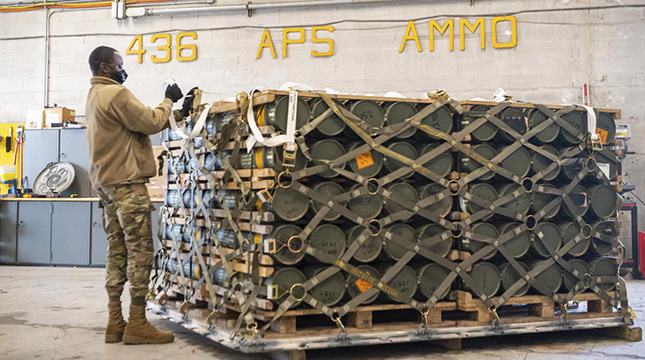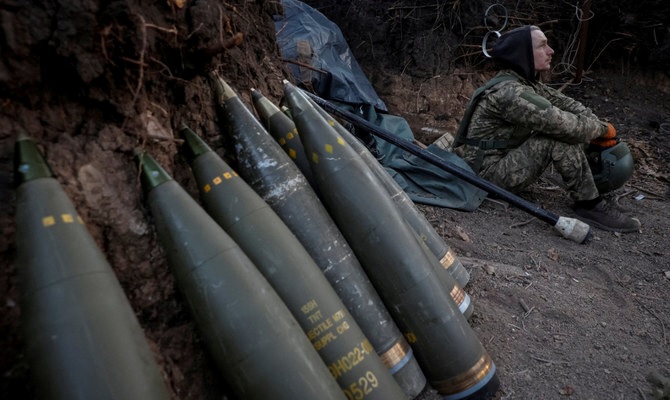 Photo: AP
Photo: AP
Admiral Sam Paparo, head of US Indo-Pacific Command, says expenditure of US air defences “imposes costs on the readiness” of America to respond to China.
Conflicts in Ukraine and the Middle East are eating into US stockpiles of air defences, the top US admiral overseeing American forces in the Asia-Pacific region has said.
The admission by Admiral Sam Paparo on Tuesday could draw the attention of members of President-elect Donald Trump's incoming administration, who are more sceptical of the war in Ukraine and who argue that President Joe Biden has failed to prepare for a potential conflict with China.
“With some of the Patriots that have been employed, some of the air-to-air missiles that have been employed, it's now eating into stocks and to say otherwise would be dishonest,” Paparo, head of the US Indo-Pacific Command, said during an event.
Paparo said the expenditure of US air defences “imposes costs on the readiness” of the United States to respond in the Asia-Pacific, particularly given that China is the most capable adversary in the world.
 The Pentagon will send Ukraine at least $275m in new weapons, US officials said.
The Pentagon will send Ukraine at least $275m in new weapons, US officials said.
Photo: Reuters
Regardless of the merits or demerits of the Biden administration’s policies on the wars in Ukraine and Gaza and the wider Middle East, it has become clear that the United States has been using and giving away its missiles faster than it can produce them, writes ‘The Responsible Statecraft’.
It is also clear that from the perspective of missile inventories and production, the United States is far from prepared to engage confidently in a sustained direct conflict with a peer competitor like China.
This is demonstrated by the fact that U.S. missile and artillery shell reserves are currently inadequate to provide Ukraine with what it needs to keep its missile defense systems supplied with interceptors. Indeed, the inability of the United States and its NATO allies to provide enough air defense missiles — A.K.A. interceptors — has made it easier for Russia to attack and destroy key military targets, as well as cripple Ukraine’s energy infrastructure.
While the United States is not going to run out of missiles tomorrow, its missile inventory, both offensive and defensive, is dwindling. Further, although the U.S. government has not disclosed how many interceptor missiles have been given to Ukraine to supply the billions of dollars’ worth of NASAM, Hawk, and Patriot air defense systems Washington sent there, we do know that it has not been enough.
We also know that between Lockheed Martin and Raytheon, some 740 Patriot PAC-2/PAC-3 missiles per year will be made in 2025, with production theoretically ramping up to roughly 1,100 missiles by 2027. That sounds like a lot, but since February 22, 2022, Ukraine has faced attacks from thousands of drones and missiles.
Moreover, while our proxy war on Russia has strained U.S. resources, an outbreak of hostilities with China could easily increase the burn rate of U.S. ship-based missiles by an order of magnitude over what we have been seeing in the Middle East. And speaking of the supply of ship-based missiles, as of Feb 1, 2024, the U.S. Navy had used at least 100 of its standard series class missiles in the Red Sea.
A July 2024 report reveals that the Dwight D. Eisenhower Carrier strike group expended 155 multi-million-dollar standard series missiles, 135 multi-million-dollar Tomahawk cruise missiles, 60 multi-million dollar air-to-air missiles, and an additional 420 air-to-surface munitions with a cumulative cost likely in the hundreds of millions of dollars And this missile expenditure does not include the missiles used by warships not attached to that strike group during this period.
Naturally, since July, the Navy has continued to use overpriced, ridiculously expensive missiles to shoot down cheap Houthis drones and missiles. Adding to U.S. Navy’s missile burn rate, on at least two occasions, April and October of this year, our warships used SM-2 and SM-3 missiles to protect Israel from Iranian ballistic missiles and drones. Additionally, since the beginning of the year, the U.S. Navy has been using the much more expensive SM-6 missiles, along with SM-2s, in its Red Sea operations.
The entirety of U.S. Navy warships, not including quad packs of shorter-ranged air defense missiles, can carry about 10,000 missiles in their vertical launch systems that can be used for wide-area defense or long-range attacks. So, as things stand, once USA expend the full complement of VLS launched missiles, the U.S. Navy is roughly 3,000 missiles short of being able to fully replenish American ships.
In April of this year, two of our Arleigh Burke guided missile destroyers used four to seven of these scarce SM-3 missiles to attempt the interception of ballistic missiles fired by Iran. Each of the SM-3s, depending on the model, costs between $13 and $28 million. Hence, that one engagement cost U.S. taxpayers in the neighborhood of $52M to $196M.
Of course, U.S. supplementation of Israel’s defenses has not been limited to expending shipborne missiles. On October 21, Israel received one of the United States’ seven THAAD air defense systems. Each of these systems costs over a billion dollars, and each THAAD interceptor missile costs $13 million. Given that the full load for the THAAD system USA sent to Israel is 48 missiles, it is safe to assume Israel has received a minimum of $600 million dollars’ worth of interceptors.
For reference, as of December of 2023, the U.S. had built some 800 of these interceptors. This means if Israel ends up receiving a few reloads, U.S. could easily see 25 percent of THAAD interceptors inventory consumed at a replacement cost of $2.5 billion.
What’s more, as of 2023, Iran is believed to have over 3,000 ballistic missiles and many thousands of drones. Consequently, Iran could launch even larger attacks in the near future, necessitating the deployment of additional U.S. systems to supplement Israel’s strained air defenses to an even greater extent.
However, all of the above would amount to chump change should the United States become embroiled in a war with China. If such a disaster were to occur, Washington could easily find itself blowing through its missile stocks in a matter of months or even weeks.
Indeed, a Center for Strategic and International Studies report found that, in order to counter China, the United States could end up expending 5,000 long-range missiles in just 3 weeks.

Europe’s arsenals almost totally expended, ‘The Military Watch Magazine’ confesses.
The Netherlands has delivered three surface to air missile batteries from the MIM-104 Patriot system to the Ukrainian Armed Forces, with Dutch Defense Minister Ruben Brekelmans having confirmed the transfer on November 28. The Northern European state was one of the first three to deliver Patriot systems in early 2023 alongside the United States and Germany, with all three having sustained deliveries, while other NATO member states, such as Spain, began to make donations later on. The Netherlands is one of the few states that is still able to make deliveries, with other arsenals across the continent having been excessively depleted.
The donations of Patriot systems on a very large scale have undermined the long range air defence capabilities of states across Europe, and left the United States’ own arsenal thinly stretched, particularly in light of the increased pressure it faced in the Middle East from late 2023.
The need to deliver more Patriot systems has continued to grow as Ukraine’s arsenal has been depleted, and as footage has continued to emerge confirming losses of the systems to Russian missile attacks.
…It becomes clear why the entire Western press is full of articles calling for “negotiations with Russia on Ukraine.” There is no longer any talk of a “strategic victory over Russia.”
But Russia needs the achievement of its goals - denazification and demilitarization of the Kyiv regime, and besides - Russia has its own conditions for negotiations.
read more in our Telegram-channel https://t.me/The_International_Affairs

 11:44 05.12.2024 •
11:44 05.12.2024 •






















